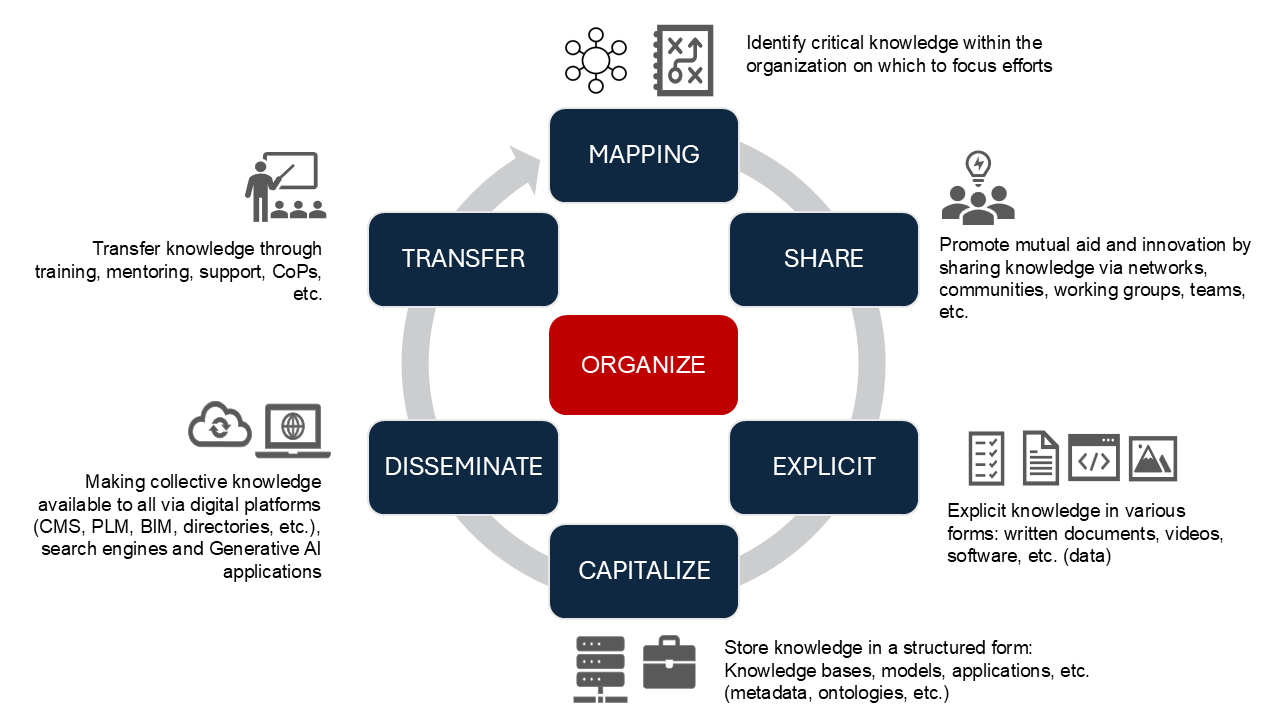A Knowledge Management System in my Company – What for?
A few challenges
- We keep redoing what has already been done elsewhere in the company.
- We don’t learn from our mistakes.
- Our field staff doesn’t have access to the right knowledge.
- We have lost the knowledge of experts who have left the company.
- Our Mergers & Acquisitions do not properly incorporate the new teams.
- We don’t innovate enough.
- We’re losing the memory of past major projects.
- Our employees are not engaged enough.
- New employees are not learning their new skills fast enough.
The Solution: the Knowledge Management System
The “knowledge cycle” represents the various stages involved in progressing from tacit knowledge (owned by individuals) to explicit knowledge (owned by the organization) and vice versa.

Six main stages are commonly used to move from knowledge acquired through one person’s experience to knowledge that can be disseminated and reused by everyone in the organization:
1 Mapping
Mapping the critical knowledge of a team, department or entire organization is often a good starting point for focusing the KM system on knowledge that is important for mission continuity, security or competitive advantage.
2 Sharing
This involves people working together on the same project (team) or on similar activities (community). Through their interactions, they learn from each other and create new knowledge in the form of best practices or recommendations.
3 Explicitation
These “knowledge object” creation activities convey validated knowledge: courses, naturally, but also methods and tools in a variety of formats: text, image, video, software… The aim of explicitation is to transform acquired knowledge into transferable knowledge.
4 Capitalization
Originally used to classify documents so that knowledge objects can be found quickly, by extension capitalization refers to activities that associate metadata with content so that it can be understood by machines (search engines, symbolic AI, Gen AI, knowledge graph).
5 Dissemination
Dissemination refers to making the organization’s knowledge available via digital platforms and applications, including search engines. The trend is towards platform specialization by content type (format), use case and UX (corporate Wikipedia, KM Portal, EDM, etc.).
6 Transfer
Training, mentoring and companionship activities traditionally enable a “master” to pass on knowledge to a “disciple”. Various media can be used for this purpose (courses, tools, recordings, etc.), while dialogue remaining central.
What are the expected outcomes of a KM system?
1 Achieving operational excellence
Move fast and save time
- Productivity increases, because knowledge is more quickly accessible.
- Additional working hours are avoided thanks to an efficient KM system.
Keep your commitments
- The risk of making costly mistakes is reduced, thanks to access to the collective knowledge acquired by the organization on all past projects.
- Projects are completed on time thanks to improved cross-functional collaboration.
2 Developing collective competencies
Accelerating competency development
- Beyond training, employees connect with their peers within communities of practice.
- All the knowledge that employees need is available to them when they need it, where they need it – in the field.
Integrating teams
Organizations that bring their teams together, whether during mergers and acquisitions or the execution of major equipment programs:
- adopt a common language to avoid costly mistakes due to differences in interpretation of the meaning of words,
- share knowledge to avoid duplicating work.
3 Sustaining the organization
Promoting a culture of innovation
- Innovation is based on a foundation of acquired and shared knowledge: documents, models, equations, directories, etc.
- Communities of exploration develop strategic knowledge that contributes to performance.
Keeping a living memory of the past
- Long-cycle organizations preserve the memory of projects, problems encountered, solutions found, unresolved issues and lessons learned.
4 Promoting employee engagement
Daily life
- Help them solve day-to-day business problems: what to do, how to do it, who to contact.
Job security
- Ensure they remain aligned with best practices and benefit from a broad, validated knowledge related to their areas of intervention.
- Maintain their knowledge and know-how at the highest level, to ensure their employability.
The need to feel part of a community
- In communities of practice, everyone is both recognized by their peers and learning.
Esteem and recognition
- An expert career path provides experts with recognition by management and by their peers.
Some achievements of Amallte
- Industrial consortium: Benchmark, definition of KM strategy, action plan for the consortium, best practices for reuse.
- French multinational: Design of KM action plan, implementation of a community program, a corporate Wikipedia, project lessons learned and an expert career path.
- Industrial company: Identification of critical knowledge, KM action plan.
- Employers’ federation: Identification of critical knowledge, action plan, launch of three KM initiatives.
Where to start?
Our customers usually ask us to start by:
- Carrying out a SWOT analysis, to help them benchmark with other similar organizations.
- Propose recommendations for KM initiatives to be launched, in response to the weaknesses identified in the SWOT.
- Organize workshops to capture and map the critical knowledge of knowledge workers in a strategic area, so that pilot KM initiatives can be launched to share, capitalize on and disseminate this knowledge.
To know more
Call to Action – Free diagnosis
To start a KM initiative or project, contact me to exchange views on your needs and our business cases.
Book a free 45-minute diagnosis https://www.amallte.com/Diag-EN



Trackbacks & Pingbacks
[…] A Knowledge Management System in my Company – What for? […]
Leave a Reply
Want to join the discussion?Feel free to contribute!